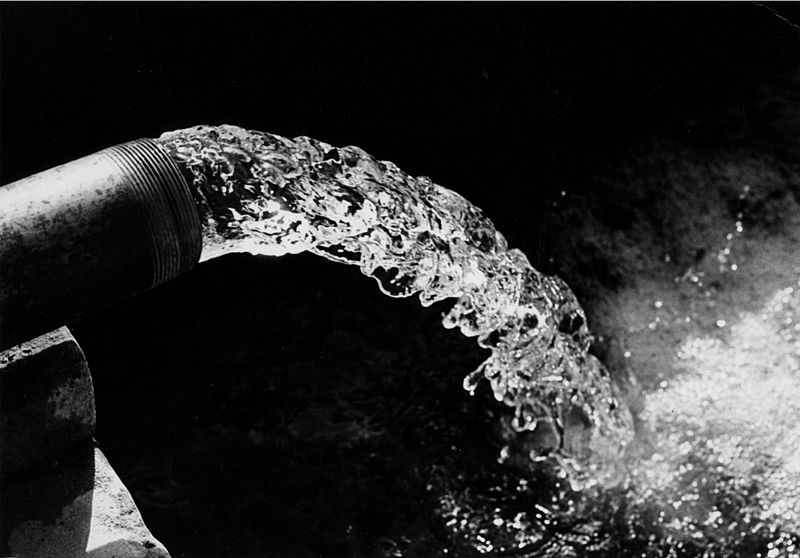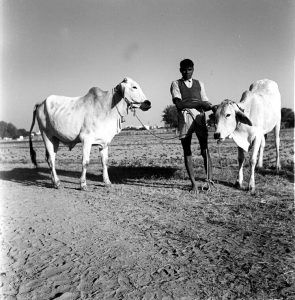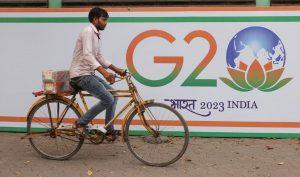Although Modi’s BJP dominates parliament after a big win in last year’s election, he needs to tread a fine balance between shifting to less water-intensive crops and ensuring his government produces enough food to feed the poor.
On a scorching summer day in northern India, Ajay Singh sat next to his water pump and scanned his 10 acres of farmland. He once used to grow rice each season to bring in about 150,000 rupees ($2,000) a year, well above the average income in the world’s second-most populous country.
Now on six acres he’s cultivating pearl millet, cow peas, bottle gourd and corn — crops that consume about 80% less water than rice, and also use less labor, fertilizer and electricity. While a water conservation program pays him 7,000 ($93) rupees per acre to plant them, it’s still a gamble: Unlike rice, which the government always buys at a set price, these crops have no guaranteed market.
“I am taking this risk because I have a passion to leave enough water for future generations,” Singh said from his farm in Karnal, an area a few hours drive north of the capital, New Delhi.
India’s 1.3 billion people have access to only about 4% of the world’s water resources, and farmers consume almost 90% of the groundwater water available. As global temperatures rise and overuse of water depletes existing resources, the threat to lives and businesses in Asia’s third-largest economy is projected to grow.
Water shortages are already acute: nearly half the country’s population faces high-to-extreme water stress and about 200,000 die each year due to inadequate access to safe water. Stoked by climate change, the water crisis has forced Prime Minister Narendra Modi’s government to try and turn around decades of established farming practices and convince the country’s most powerful voting bloc to change the crops they plant. Water-guzzlers like rice and wheat are out, corn and pulses are in.
“This is just the beginning,” Siraj Hussain, former secretary of agriculture and a visiting senior fellow at the Indian Council for Research on International Economic Relations in New Delhi, said of the program farmers like Singh have joined. “Sooner or later, it will have to be replicated across the country. Ideally, the central government should finance part of the expenditure in providing incentives to the farmers for making the shift from paddy and sugarcane. States alone can not afford such an ambitious plan.”
Powerful Bloc
For Modi, pushing farmers to change is risky business because of their sheer numbers and political power. Farm income is untaxed in the South Asian nation, and water and electricity are heavily subsidized. Lowering the minimum price at which the government buys food grains from farmers could also backfire at the polls.
Although Modi’s Bharatiya Janata Party dominates parliament after a big win in last year’s election, he needs to tread a fine balance between shifting to less water-intensive crops and ensuring his government produces enough food to feed the poor. That makes incentives like those given to farmers like Singh an important test for whether India can reverse its chronic water problems.
If the program in Karnal is any indicator, the task isn’t going to be easy.
Few farmers in the rice-growing district, where the water table has been declining by 0.7 meter every year, are keen to experiment with new crops. In its first year in Haryana the project anticipates around 100,000 hectares (247, 105 acres) would switch to alternate crops — but that’s only about 7% of the land used for rice cultivation in the northern state.
Farmers love rice and wheat primarily because of stable prices and assured state purchases. These two staples, along with another thirsty crop, sugar cane, are grown in 40% of the country’s gross farmed area but consume about 80% of its irrigation water. Corn and millets may use less water, but their price stability is unproven.
Farming Gamble
In the long run, experts say water shortages will make crop diversification an inevitability. Currently India is the world’s biggest extractor of groundwater — more than China and the U.S. combined — accounting for almost a quarter of the total extracted globally. Between 2000 and 2017 its groundwater depletion increased by as much as 23%.
But the change needs to be carefully managed, said Aditya Pratap Dabas, deputy director agriculture and the officer managing the Karnal project. “Changing the farmers’ mindset is the main challenge in implementing the program.”
Heavier tactics backfire. Protests erupted earlier this year when the provincial government tried to restrict rice cultivation to just half the farmed area in some parts of Haryana. The farmers, some backed by the opposition Congress party, said the government couldn’t deprive farmers of the right to grow crops that fetched the best price.
It will take time to change the mindset of farmers, said Rajinder Singh, 61, an activist with four decades of farming experience who is now urging others to join the program. “The government should give assurance to procure these crops, more access to market and set up infrastructural facilities like cold storage,” he said.
Green Revolution
India’s food policy has remained focused on wheat and rice since the 1960s, when the Green Revolution changed the farming landscape and made the country food self-sufficient for the first time.
The road to becoming the world’s second largest producer of those two staple grains was paved by federal and state subsidies for fertilizer, power and water. The crops are then purchased by governments — even in times of glut — at a minimum support price. For India’s farmers these are hard habits to break.
“Diversification incentives are not a bad idea,” said Ila Patnaik, former principal economic adviser to the federal government and a professor at the National Institute of Public Finance and Policy. “Many of these reforms will have to be demonstrated to farmers before they gain faith in the government. We must also give time for reforms to play out.”
Besides Haryana, some other states have indirect programs to motivate farmers to move to less water intensive crops. Northern Punjab, a major producer of wheat and rice, is offering cash incentives to farmers who use less electricity to extract ground water. In Maharashtra, home to the financial hub Mumbai, farmers are encouraged to use drip irrigation for sugarcane cultivation.
But for Mahavir Sharma, a 63-year-old farmer in Karnal, it was water scarcity in his part of Haryana that pushed him to start experimenting with corn on four of his 19 acres.
Source: https://bit.ly/3jxoVJc





